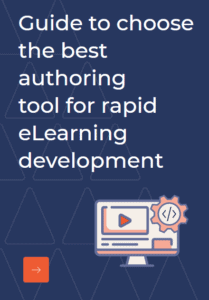The term Rapid as we all know stands for speedy or swift and in eLearning it translates to quick eLearning development using authoring tools. However, the fact that it gives a quick turn-around and that tools have many templates that can be used doesn’t make Rapid eLearning development any simpler.
As discussed previously the cost and time elements should not impact its credibility nor quality and also burst some myths surrounding rapid development, that often influence the decision making. Rapid development is no different from regular eLearning development in the initial stages, only the development and testing steps required consumes lesser time, which includes template design, asset creation and even translations at times ( Ref: Articulate Storyline 360 latest release ). Having said that , any successful Rapid eLearning requires advance planning and clear understanding of the authoring tool to be used. There are various other aspects too. Here are some tried-out ways to make rapid eLearning development successful.
- Analyse and Understand the Learning Objectives (Goals) Well
As for any eLearning development, analysing the requirements well, understanding the expectations of the target audience and the organizational goal allow to conceptualize successful rapid learning solutions. It is essential to know what the learning content is going to be used for, i.e. for performance support or as stand-alone course or in a blended environment, this greatly influences the learning design. - Keep the Raw Content at Hand
Once the need analysis is done, the next step includes information gathering. Ideation/concept design on tools from which content can be directly imported can make the work easier. If rapid eLearning development is done for converting the existing ILT/classroom training to eLearning then collect all the existing content, fill in the information gaps and update those that are necessary. This is followed by concept design, or organization of information into sections and subsections. - Identify the authoring Tool that best fits the Need
Every authoring tool will have its own uniqueness and hence identifying the right authoring tool suiting your requirement is highly important. The authoring tool to be used should fulfil the learning requirements, analysing the cost factors, looking closely at the kind of interactivities, assets etc. that it offers. It is also good to understand how simple or complex the authoring tool is, this helps in identifying the right resource for successful rapid learning development. - Making Best Use of the Authoring tool
This could often be the key for on-time delivery and successful development. Utilize the in-built templates, animations, stock images, and other assets to get the best output. Creating a standard template for use, helps in delivering consistent output. This also applies for branding requirements, hence decreasing the work if similar courses are to be made for the same organization. - Be Open to Changes
Iterations are often required, and the success of rapid eLearning development too depends prompt on iterations and modifications. The use of authoring tools surely makes the process easier. Rapid eLearning development not only makes learning development easier and faster, it also makes changes and modifications easier. This also works well for changes in technology etc. provided the authoring tool developers update the software from time-to-time.
While, the level of customizations may not match that of custom development, rapid eLearning is still capable of motivating the learners and achieving the learning outcomes. Following the above mentioned aspects can ensure a successful rapid eLearning development, and if you still need help just send your query to info@www.knowzies.com.



